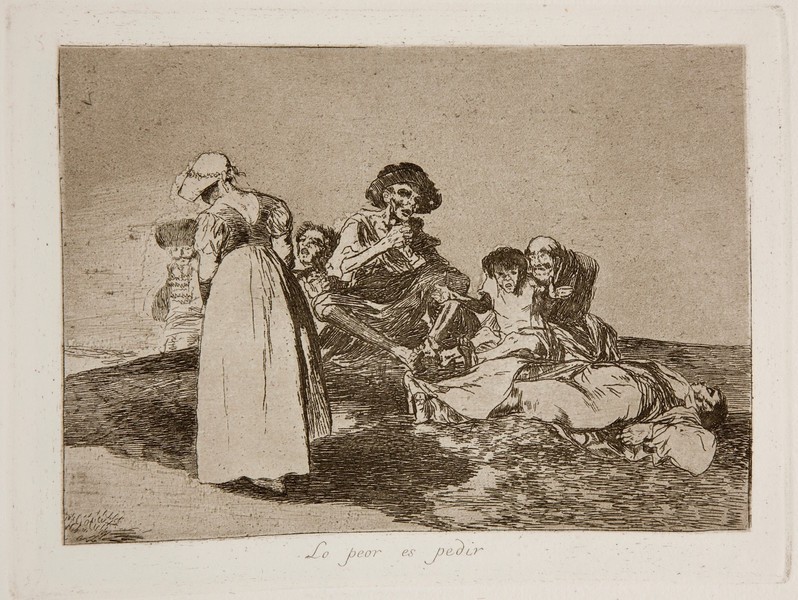- Cronología
- Ca. 1812 - 1815
- Dimensiones
- 154 x 207 mm
- Técnica y soporte
- Aguafuerte, lavis y bruñidor
- Reconocimiento de la autoría de Goya
- Undisputed work
- Ficha: realización/revisión
- 16 Dec 2010 / 02 Jun 2023
- Inventario
- 225
Goya (lower left-hand corner, with the "y" written backwards); 37 (lower left-hand corner).
See Sad presentiments of what must come to pass.
The second artist's proof shows that the lavis extends up to the edges of the plate with light burnishing on the ground area and the sky towards the left-hand edge.
The title was handwritten on the print by Goya in the first and only series that is known to have been printed at the time the works were created, which the artist gave to his friend Agustín Ceán Bermúdez. Therefore, the title was etched into the plate at a later date and left unchanged as of the first edition of the Disasters of War printed by the San Fernando Royal Academy of Fine Arts in Madrid in 1863, after the printing of the series in the possession of Ceán Bermúdez.
There is a surviving preparatory drawing for this print which is housed in the Prado Museum in Madrid.
In this print Goya continues to explore the subject of famine begun in print no. 48, A cruel shame! (Cruel lástima). In the middle of a waste ground a group of starving people beg the help of a young woman who passes by them, head lowered. In the background a French officer watches the scene.
Goya has left the sky completely clear, omitting the aquatint he uses for skies in other works. The faces of the starving figures in the centre of the composition are picked out in aquatint. Their faces are gaunt, their eye sockets sunken, while their legs and arms are mere bones and their clothing is ragged.
The well-dressed young woman has been the subject of much discussion. Eleanor Sayre believes that it might be the Spanish wife of the French officer that also appears in the print: a depiction of a mixed marriage. Lecaldano suggests that this figure might be a young middle-class woman who cannot bear the sight of the starving people and for this reason turns her gaze away from them, although he does not link her to the soldier in the background. Jesusa Vega and Juan Carrete raise the possibility that the figure is a prostitute, a profession that offered many women a solution to the difficult circumstances caused by the war. This would explain why the young woman does not look at the dying figures as she passes by, her gaze fixed on the French officer who would represent the best potential client of the time.
The plate is stored in the National Chalcography (cat. 306).
-
Goya y el espíritu de la IlustraciónMuseo Nacional del PradoMadrid1988from October 6th to December 18th 1988. Exhibited also at Museum of Fine Arts, Boston, January 18th to March 26th 1989; The Metropolitan Museum of Art, Nueva York, May 9th to July 16th 1989, Madrid curator Manuela B. Mena Marqués, scientific directors Alfonso E. Pérez Sánchez and Eleanor A. Sayrecat. 91
-
Francisco de GoyaMuseo d'Arte ModernaLugano1996exhibition celebrated from September 22nd to November 17th.cat. 55
-
Francisco de Goya: Maleri, Tegning, GrafikkNasjonalgallerietOslo1996from 10th to April 14th 1996cat. 145
-
Francisco Goya. Sein leben im spiegel der graphik. Fuendetodos 1746-1828 Bordeaux. 1746-1996Galerie KornfeldBern1996from November 21st 1996 to January 1997cat. 139
-
Ydioma universal: Goya en la Biblioteca NacionalBiblioteca NacionalMadrid1996from September 19th to December 15th 1996cat. 222
-
Goya. Opera graficaPinacoteca del Castello di San GiorgioLegnano2006exhibition celebrated from December 16th 2006 to April 1st 2007p. 78
-
Goya en tiempos de guerraMuseo Nacional del PradoMadrid2008consultant editor Manuela B. Mena Marqués, from April 14th to July 13th 2008cat. 108
-
Goya luces y sombrasCaixaForumBarcelona2012consultant editors José Manuel Matilla and Manuela B. Marqués. From March 16th to June 24th 2012cat. 48
-
Goya et la modernitéPinacothèque de ParisParís2013from October 11st 2013 to March 16th 2014cat. 94
-
2022
-
Goya, grabadorMadridBlass S.A.1918cat. 157
-
Goya engravings and lithographs, vol. I y II.OxfordBruno Cassirer1964cat. 175
-
Vie et ouvre de Francisco de GoyaParísOffice du livre1970cat. 1084
-
Goya y el espíritu de la IlustraciónMadridMuseo del Prado1988p. 309-310, cat. 91
-
Catálogo de las estampas de Goya en la Biblioteca NacionalMadridMinisterio de Educación y Cultura, Biblioteca Nacional1996cat. 265
-
El Libro de los Desastres de la GuerraMadridMuseo del Prado2000pp. 105-107
-
ParísPinacoteca de París2013p. 147
-
Goya. In the Norton Simon MuseumPasadenaNorton Simon Museum2016pp. 114-151
-
Museo de Bellas Artes de Badajoz y Diputación de Badajoz2022p. 76

